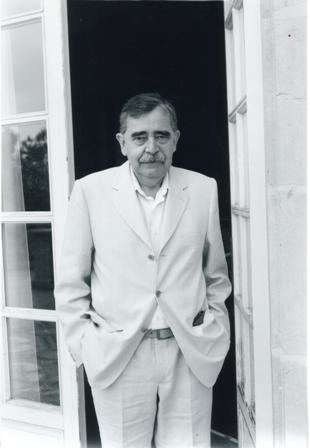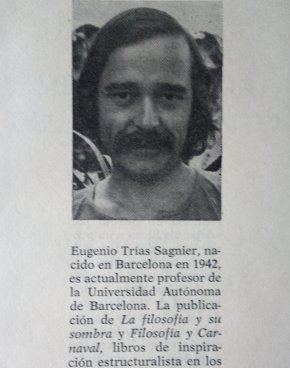Name Eugenio Sagnier | ||
 | ||
Eugenio Trias (31 August 1942 – 10 February 2013), was a philosopher. He is regarded by the majority of the critics as the most important thinker since Ortega y Gasset in the philosophical literature written in Spanish.
Contents
Biography

Trias was born in Barcelona. After obtaining his bachelor's degree in Philosophy at the University of Barcelona in 1964, he continued his studies in Pamplona, Madrid, Bonn and Cologne. Since 1965 he was Assistant Professor and, later, Associate Professor of Philosophy at the University of Barcelona (UB) and the Universitat Autònoma of Barcelona (UAB). In 1972 he stayed, for one year, in Brazil and Argentina, where he offered several courses and lectures. In 1976 he became Assistant Professor of Aesthetics and Composition at the School of Architecture of Barcelona. In 1986 he gained the Chair of Philosophy at this University, where he remained until 1992. In 1992 he became Chair Professor of Philosophy at the Pompeu Fabra University in Barcelona, where he remained as a Professor of History of Ideas until his death, aged 70, in his home city.
Thought

He has an encyclopedical conception of philosophy and has spread his ideas in very diverse fields such as ethics, politics, aesthetics, philosophy of religion, philosophy of history, theory of knowledge, and ontology. He has dealt with almost every field where philosophy can be applied. His preferred fields, nevertheless, have been, above all, Philosophy of Arts and Aesthetics, on the one hand, and Philosophy of Religion, on the other. He has always tried to derive his whole thought from his own personal conception of ontology, which is usually called the “Philosophy of Limit”. Many of his books have already become obligatory references in the Spanish written philosophical heritage of the last 60 years. Some of his works such as Treaty on Passion, Beauty and the Sinister, The World's limits or The Age of the Spirit have become classics of the Spanish written philosophical thought of the 20th century.

His work is regarded by the critics as one of two most significant philosophical pillars of the contemporary Spanish thought. Critics have praised his work for his particular style of writing (in which the philosophical thought gets poetic antennas with a great literary value). His works have been regarded not only a very important contribution to the Spanish philosophical and cultural heritage, but also an enormous textual production that will remain as one of the most reliable milestones of his generation in the fields of the philosophical literature and of the knowledge-oriented writing. Trias has published over thirty-five books, some of which have had several editions in Spain and abroad. His first book, The Philosophy and its shadow, published in 1969, was hailed by critics as an event in the Spanish cultural life. It was regarded as "the philosophy of a new generation" (Josep Maria Carandell). In his latest two books The Sirens Chant – which has become a non-fiction bestseller in Spain– and The Sonorous Imagination Trias holds that there is a need of a musical turn in the philosophy of the 21st century to make thought change its gravity center, to musical aspects instead of language, since the former represents the most perfect synthesis of beauty and knowledge.
The main topics of his Philosophy

According to the most recent book on Trias, Reason and revelation, these have been –in chronological order– the main topics of Trias philosophical works: • The shadows of the philosophical theories • The reason of the irrational • The artists and their society • The Sinister as the limit and condition of beauty • Passionate love as the basis of intelligence • The Modernity crisis • The human condition as a bordering existence • The religious experience • The beauty and the sacred • A new ethics as an ethics of limit • The musical turn of the Philosophy
His main contributions to Philosophy

As an alternative to a narrow-minded rationalism –such as the logical positivism, the analytical philosophy or the Marxist thought–, Trias, who has never been an irrationalist philosopher, intends to extend reason to those spheres which are still reluctant to it, although they can somehow impregnate it. Some examples of these spheres are: the irrationality and the madness (in his book Philosophy and carnival); the mythical and magical thought (in his book Methodology of magical thought); the passionate love (in his book Treaty on passion); the Sinister (in his book The beauty and the sinister) as a shade of the categories of beauty and the sublime which founded the traditional aesthetics; or the world of religions as the shadow of the modern Western reason (as shown in his The age of the Spirit). That is the reason why Eugenio Trias considers himself as an "illuminist exorcist" who exposes the philosophical reason to a permanent dialogue with their shadows. But the most significant innovation of Trías philosophy appeared in the early 1980s, when he found out the cornerstone of his Philosophy, namely, the concept of limes (or, "limit"). He states that being (whose issue has always been the main question for Western philosophy from its origins) may be understood as “being of limit”, that is, the border area that separates as well joins the phenomena and the noumena. Whereas in Kant's thought there was not such a limit or borderline that merges and splits the phenomenon and the thing-in-itself, Trias holds that such a limit exists. He states that it is a precarious, delicate, subtle but founding isthmus. And it is just the very being that philosophers intend to define. That limit is also the boundary between the reason and its shadows. His concept of the limit is the result of an intense dialogue with the Kantian tradition, Wittgenstein and Heidegger. In fact, all his work is a very developed comentary on the Wittgenstein's statement "subject is a limit of the world." Trias develops an anthropology in which the person is conceived as an inhabitant of the being's limit. On this respect, person is always referred to the abovementioned limit which for Trias has an ontological significance.
Prizes and Awards
Trias has won many prizes and awards for his creative work. Among them, these are the most important ones: • In 1974 he received the New Critics Award for his book Drama and identity • In 1975 he received the Anagrama Essay Award for The artist and the city • In 1983 he was awarded with the Spanish National Essay Prize for Beauty and the sinister • In 1995 he received the Ciutat de Barcelona Award, for The age of the Spirit • In 1995 he won the 13th Friedrich Nietzsche Prize for his collected philosophical works. This award (won also by other distinguished thinkers such as Popper, Rorty or Derrida) is, in its absence, an equivalent to the Nobel Prize of Philosophy, due to the fact that it is the only international award given to a philosopher in recognition of his entire career. Eugenio Trias is the only philosopher in Spanish language who has received this award. • In 1997 he was awarded with the Medal of the City of Buenos Aires • In 2000 the Autonomous University of Santo Domingo (UASD) gave Trias an Honoris Causa Doctorate • In 2003 the National University of San Marcos Lima (UNMSM) gave him an Honoris Causa Doctorate • In 2004 he received the Gold Medal of the very prestigious Circulo de Bellas Artes de Madrid • In 2006 the Autonomous University of Madrid (UAM) gave Trias –together with Jose Saramago– an Honoris Causa Doctorate • In 2007 his best-seller book The Sirens chant" received two awards as the best essay of the Year: the Terenci Moix and the Qwerty prizes • In 2009 he received the Mariano de Cavia Award, for his article The great travel, published by the ABC newspaper • In 2010 he received the Creation Prize of Extremadura, a very prestigious official award • He has been Vice-president of the Reina Sofia National Museum (Madrid) and Chairman of the Advisory Council of the Institute of Philosophy at the Centro Superior de Investigaciones Cientificas of Spain.
Works
• Philosophy and its shadows (1969, three editions) • Philosophy and Carnival (1970, 3 editions) • Theory of ideology (1970, 3 editions) • Methodology of magical thought (1971) • Drama and identity (1973, 3 editions) • The artist and the city (1975, 3 editions) • Meditation on power (1976, 2 editions) • The lost memory of things (1977, 2 editions) • Treaty on passion (1978, 5 editions) • The language of forgiveness. An essay on Hegel (1979) • Beauty and the Sinister (1981, 5 editions) • Philosophy of the future (1984, 2 editions) • The world's limits (1985, 2 editions) • The philosophical adventure (1987) • Limit's logic (1991) • The tiredness of the West (1992, 4 editions), with Rafael Argullol • The age of the Spirit (1994, 3 editions) • Thinking religion (1997, 2 editions) • Vertigo and passion (1998, 2 editions) • The borderline reason (1999) • City over city (2001) • The life's tree (2003) • The truth's thread (2004) • Politics and its shadow (2005) • The Sirens chant (2007) • Philosophical creations (2009), a selection of his collected works (2 volumes) • The sonorous imagination (2010)
